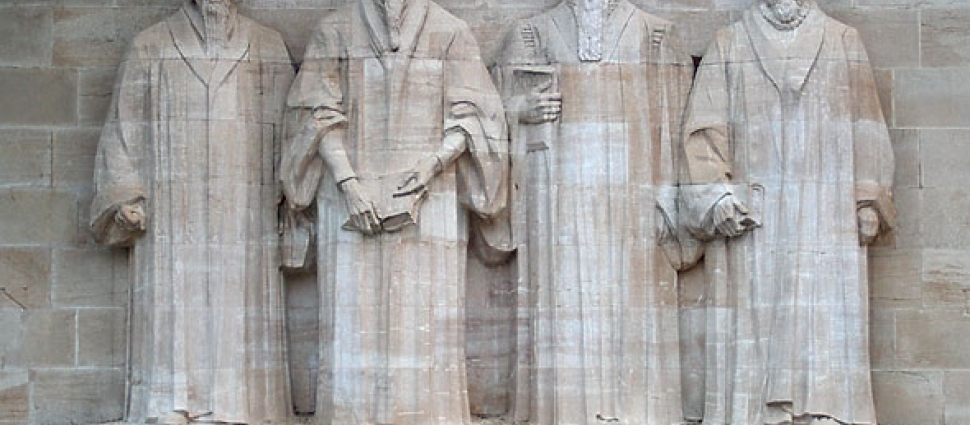The Dispute of Tirano and the Trial of Calvin’s Orthodoxy

The Dispute of Tirano and the Trial of Calvin’s Orthodoxy
In the eventful sixteenth century, few people took notice of a court trial in a small town on the Italian side of the Alps. And yet, the stakes were high.
It all started on May 1, 1595, when Simone Cabasso, parish priest of Tirano, preached from the pulpit that John Calvin denied the divinity of Christ. It was a serious accusation, all the more because of the town’s unusual circumstances.
From 1512, the region including Tirano, known as Valtellina, had been under the Free State of the Three Leagues (today known as the Grisons). Dealing with a population of both Roman Catholics and Protestants, a 1526 diet (Diet of Ilanz) had taken some preventative measures, placing limitations on the authority of Roman Catholic bishops over the general population and condemning acts of defamation or disturbance to the religious peace. Infractions to these statutes could be punished by death.
Most of the time, Simone Cabasso and Antonio Andreassi, pastor of Tirano’s Reformed church, had been coexisting peaceably. But when Andreassi learned of Cabasso’s sermon, he thought the matter was serious enough to be brought to the authorities.
It was a bold action in a town where Protestants amounted to about one hundred in a population of 4000. What’s more, the Catholic population was militant against Protestants. A legend told that the statue of the Archangel Gabriel, standing on top of their Basilica, had spontaneously turned, pointing its sword against the northern, Protestant nations.
It was also a risky action. If the authorities found Cabasso correct in his statement, the Reformed population (then commonly referred to as Calvinist) could be legally expelled as heretics. On the other hand, if Cabasso were found guilty, he could lose his life.
A Long Trial
The matter was assigned to the local magistrate, the Roman Catholic Nicola Marca, who convened a delegation to examine the matter. The discussions lasted many days, in front of a large crowd of curious viewers. New sessions were held between September 16, 1595 to March 1, 1596. Until the matter was resolved, the magistrate ruled that neither Catholics, nor Protestants were allowed to bring up the issue in public.
Cabasso stood by his statement, asserting that Calvin, in the second book of his Institutes of the Christian Religion, chapter 14, had expressed the unity of the two natures of Christ in his role as mediator in a way that suggested that his human nature was lesser than the divine. Many Christian authors were quoted in the course of the discussion, including Augustine, Ambrose, Robert Bellarmine, and Protestants such as Guillarme Budé and Philippe du Plessis-Mornay.
The last session included representatives of the Three Leagues State, proof that the debate had become a matter of concern to the national peace.
A sentence was finally passed on January 7, 1987, ruling that “Calvin thought and wrote in a just and orthodox manner regarding the divinity of Christ,”[1] and that Cabasso was therefore guilty of defamation. The priest was, however, given the relatively small penalty of 130 crowns, possibly to avoid a potential rebellion by Catholics who would have objected to a harsher punishment.
The Aftermath
After the sentence, Roman Catholics and Protestants each published their account of the trial. Despite their defeat, Catholics believed the trial had brought to the surface other issues that, in their view, proved the Reformed should be avoided.
Cabasso went on to strengthen the faith of his parishioners in the Roman Catholic Church by publishing a book on the history of their Basilica, founded in answer to a man’s claims that Mary asked him in a vision to build her a church. A street in Tirano is named after him.
Andreossa continued to pastor the Reformed church in Tirano until 1608. Of the other participants to the dispute, Nicolò Ruspa, author of the Roman Catholic account of the events, was tried twice: once for predicting hellfire on a young Roman Catholic who attended a Reformed church; the second time on the accusation of a convict who claimed that Ruspa had encouraged him and two companions to kill the Reformed Scipione Calandrini. He was acquitted both times (although he admitted to the first offense) but, in 1618, he was taken from his house and tried again under torture, under which he died.
These are just some examples of the hostilities that continued between Roman Catholics and Reformed, despite a general effort to preserve the peace. These hostilities persisted until 1620, when the Roman Catholic party prevailed by force, causing the death of at least 400 people.[2]
Although the Dispute of Tirano has lain forgotten in most history books, it stands as an intriguing event when a Roman Catholic magistrate in a Roman Catholic town, after long deliberations by some of the best-esteemed Roman Catholic minds at that time, declared Calvin’s Christology to be “just and orthodox” and the parish priest’s accusations to be unfounded.
[1] “Quandoquidem de Christi Divinitate recte & orthodoxe Calvinus senserit, & scripserit,” in Cesare Cafforo and Octaviano Mey, Disputationis tiranensis inter pontificios et Ministros Verbi Dei in Rhaetia, Waldkirch Basilea, 1603, 289, quoted in Emanuele Fiume, “Calvinus Arianus? La disputa di Tirano (1595-1596): un processo civile alla cristologia di Calvino,” in Giovanni Calvino e la Riforma in Italia: Influenze e conflitti, ed. by Susanna Peyronel Rambaldi, Turin: Claudiana, 2011, 315–23.
[2] See Simonetta Carr, “Vincenzo Paravicino and the Valtellina Massacre,” Place for Truth, Oct 30, 2018, https://www.placefortruth.org/blog/vincenzo-paravicino-and-valtellina-ma...





